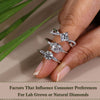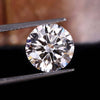
What is CVD Diamond and Why is it Changing the Jewelry Industry?
Chemical Vapour Deposition in the lab produces diamonds that are identical to those found in nature. Discover how CVD diamonds are created, how they differ from other lab-created and natural diamonds, and whether a CVD diamond is the right choice for you.
What is a CVD diamond?
The term "chemical vapor deposition," or CVD, is frequently used to refer to the procedure used to create diamonds in a laboratory. This is distinct from the HPHT (High Pressure, High Temperature) method, which is another method frequently used to produce lab-grown diamonds.

Although CVD diamonds are man-made, they are completely genuine and identical to natural diamonds. In actuality, without specialized tools, it is impossible to distinguish a CVD diamond from a natural diamond. Study the differences between lab-created and natural diamonds.
Buyers of engagement rings and jewelry are increasingly choosing lab-created diamonds, and along with HPHT, CVD is one of the most widely used production processes. While you should know CVD diamonds are typical of lower quality than HPHT diamonds, some advantages of CVD rough diamond jewelry include ethical origins, sustainability, and lower prices.
Properties Of A CVD Diamond
Natural diamonds and CVD diamonds both have the same physical and chemical characteristics and the same internal structure, and dazzling beauty. Similar to natural diamonds, CVD diamonds have exceptional endurance, ranking a 10 on the Mohs scale of hardness, and dazzling brightness.
You should know CVD diamonds frequently exhibit less desired characteristics, like brown tints and internal graining, even though it is impossible to distinguish between a lab-created CVD diamond and a natural diamond of the same quality. This shows that they frequently need post-growth care. As opposed to CVD diamonds, HPHT lab-created diamonds are often of greater grade.

CVD diamonds are rated for cut, color, clarity, and carat weight just like natural diamonds. Even though CVD is man-made, it can develop internal flaws and color tints as they grow and are susceptible to the same flaws as natural diamonds. It's uncommon to discover a completely flawless CVD lab diamond; some will be heavily included and poorly colored, while others will be completely colorless with only minute flaws, just like natural diamonds. For a diamond that looks to be of the highest quality and offers good value, look for grades between SI1 and VS1 in terms of clarity and D to F in terms of color.
Even the best gemmologists cannot distinguish between a CVD diamond and a natural diamond. This is because CVD diamonds are diamonds, that have the same precise chemical, physical, visual, and even fault characteristics as natural diamonds. When you purchase a CVD diamond, the GIA or IGI certification will specify the origin of the stone. Other than this, it would require specialized laboratory tools to determine whether the diamond was man made.
The Market for lab-grown diamonds is expected to treble by 2025
Think about these figures:
- From a few hundred thousand to approximately three million carats in 2021, lab diamonds were used in jewelry.
- The sale of jewelry made using lab-grown diamonds reached $5.9 billion globally in 2021.
- By 2025, the output of lab-created diamonds is expected to increase by $4 billion.
Despite being a small portion of the overall diamond market, which also includes mined diamonds and synthetic diamonds, etc., the market for lab-grown diamond jewelry is growing every year.

Consumer preference for lab-created rings and other sustainable diamond jewelry, quick adaptation by diamond brands and retailers to meet this growing consumer preference, the affordability of lab diamonds, and an overall rise in conscious consumption around the world are the main drivers of this increase.
How CVD Diamonds Are Changing the Jewelry Industry?
The jewelry industry has been embracing lab-grown diamonds called CVD (Chemical Vapor Deposition) diamonds recently. By providing a less priced and more environmentally friendly substitute for genuine diamonds, they are revolutionizing the business. Ten ways that CVD diamonds are changing the jewelry business are listed below.
Less-Expensive Alternative To Natural Diamonds
The fact that CVD diamonds are a more affordable alternative to natural diamonds is one of the main reasons they are revolutionizing the jewelry business. Although the cost of natural diamonds has been steadily rising over time, CVD diamonds are less expensive, making them a desirable alternative for customers looking for high-quality diamonds without breaking the bank.
Lab-Grown Supply Shortage To Change
The possibility that CVD diamonds will aid in addressing the current lab-grown diamond shortage is another noteworthy effect of these stones. There is a shortfall in the market because the supply of lab-grown diamonds not keeping up with demand. By offering a different way to create lab-grown diamonds, CVD diamonds may help to change this.

Newly Sustainable Alternative
CVD diamonds can replace natural diamonds, which may have detrimental effects on the environment and society as a sustainable alternative. Natural diamond mining may cause habitat loss, deforestation, and other environmental harm. In several of the nations that produce diamonds, there have also been worries about violations of human rights. Contrarily, CVD diamonds are grown in laboratories using sustainable practices, thus their creation does not have the same detrimental effects on the environment or local communities.
More Accurate Traceability
Because CVD diamonds are lab-grown, it is simple to determine where they came from, which is a crucial consideration for customers who are concerned about the ethical sourcing of their products. Since it's challenging to determine the origins of natural diamonds, concerns have been raised about the use of conflict diamonds or diamonds that were mined in an unsustainable manner.
Choices For Customization
Customized styles and shapes may be achievable with CVD diamonds that aren't possible with natural diamonds. For jewelry designers and buyers looking for distinctive and individualized jewelry, this creates new opportunities.

Consistent Quality
Because CVD diamonds are grown under controlled conditions, their quality can be more consistent than that of natural diamonds. This is crucial for customers looking for high-quality diamonds that will maintain their worth.
Large Size
The ability to create CVD diamonds in bigger sizes than natural diamonds is another benefit. This is so that CVD diamonds can be produced to any size while the size of the diamond crystals that are found in the earth constrained natural diamonds.
The Development Of Technology
The quality of these diamonds is projected to rise much further as CVD diamond production technology develops. This might open up new design possibilities and more customization options that weren't previously available.
Possibility Of Brand-New Applications
Electronics, medical technology, and aerospace are just a few of the industries that can benefit from using CVD diamonds. The demand for CVD diamonds may rise much higher as these applications spread.
Hanging Customer Tastes
Last but not least, the increased acceptance of CVD diamonds may be a sign of changing customer tastes in the jewelry sector. CVD diamonds are projected to gain in popularity as consumers' concerns about sustainability, ethical sourcing, and personalization grow.
Rising Demand For Jewelry Made With Lab-Grown Diamonds
Earlier, consumers primarily purchased lab-grown diamond rings, but over the past few years, this has changed. Customers are increasingly willing to investigate various types of jewelry with lab-created diamonds.
Customers are now looking for alternatives to mined diamonds in everything from earrings to necklaces, bracelets, and brooches. This trend has also gained momentum thanks to celebrities praising and supporting lab-created diamonds at red carpet events. Lab diamonds are also employed in the industry. However, the use of lab-grown diamonds for various types of jewelry is much higher than the use of diamonds for industrial purposes.
Jewelry Stores Are Switching To Lab-Created Diamonds.
More jewelry stores are switching to using lab diamonds for jewelry, such as lab created diamond rings, which are one of the most popular diamond jewelry items, to satisfy the growing demand for man-made diamonds. In a few more years, research shows that the global lab grown synthetic diamonds market will probably bring in $32740 million in sales. Compared to 2019, when the income was $19145 million, this is almost twice as much.
The Effects Of The Pandemic On The Market For Lab-Grown Diamonds
The pandemic had a bad effect on the lab-created diamond industry, much like it did on most other industries. The causes include supply chain disruptions and customers' limited purchasing power, among others.

More online marketplaces and channels replaced brick and mortar stores that were forced to close for the selling and purchase of lab-grown diamond jewelry. The post-pandemic market has seen a higher emphasis on the sustainable production of lab diamonds due to a preference for more environmentally friendly options across industries, including diamonds.
Summing It Up
In conclusion, CVD diamonds are revolutionizing the jewelry business by providing a more cost-effective, environmentally friendly, and adaptable substitute for real diamonds. The acceptance of CVD diamonds is probably only going to increase as consumer preferences and technological advancements continue to evolve.
Recent reports show that demand is growing, whether it is for lab-grown diamond jewelry or manufacturing. And several factors are working in favor of lab-grown diamond jewelry, including a growing consumer preference for sustainable diamonds, technological advancements in grown diamonds, and a switch to lab-grown diamonds by major diamond retailers and manufacturers. These factors have come together to move the lab diamond industry in the right direction.
Leave a comment
Please note, comments must be approved before they are published.









